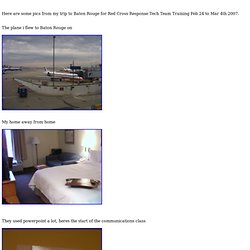

HamCity / Ham Radio Equipment. Comm box questions - AR15.Com Archive. Comm box questions I know this topic has been beat to death on here but i have a few questions on a box i want to build.

I want a box that could be used as a cross band repeater 70cm - 2m. It needs to be able to solar charge its battery. it also needs to be semi weather proof during operation. 1. what radio? I was thinking 8800 2. what antenna 3. what battery 4. what box 5. what solar charger 6. what have i forgot it also needs to function as a regular comm box Thanks Woody thats a rather expensive radio to put in a box and leave it alone. there are a LOT of 2m/70c radios that do CBR. antenna is part of it but height of that antenna is the biggest thing. also the size of the battery will depend on what power rating you want to run and for how long. the box depends, you cant have it water tight or else the heat will build up and heat is the number one killer of electronics. Radio Incident Command Kit - Emergency Radio Kit. Pics of my Trip to Baton Rouge. Here are some pics from my trip to Baton Rouge for Red Cross Response Tech Team Training Feb 24 to Mar 4th 2007.

The plane i flew to Baton Rouge on My home away from home They used powerpoint a lot, heres the start of the communications class Here are Red Cross Mobile radios (47.42 mHz) in pelican cases These can be installed quickly in vehicles (25w mobile radios) The white tubes have the 47 mHz antennas in them Here are the "base" radios in pelican cases, they are 100w mobile radios with a power supply, can be set up at shelters and kitchens Here we are outside (was 70 degs by the way)! Here is a mobile (base) radio, its bolted to the power supply and they again are 100w Here is a Red Cross 47.42 base antenna we raised Here is an ECRV (Emerg Communications Response Veh) The Red Cross has 9 of them throughout the US They have a VSAT dish for the net and voip on the roof and have red cross, other gov and non gov and ham radio radios with interconnect and autopatch Another view of the ECRV. The New QTH – A Floating Shack. This is only the second time I’ve attended what I believe is Florida’s largest annual hamfest, and so far, I haven’t ever been disappointed, torrential downpour and low 50s temps notwithstanding!

And this is just day 1 (of 3)! I’m very proud of one of my newest acquisitions – a 1962 vintage Vibroplex Original ‘bug’ with 3.5″ base and an ‘L’ damper (don’t ask – I’ll tell you below!) , serial number 226473. After getting it back to my hotel room, my first high priority task (after devouring a great salmon dinner downstairs), was to identify this baby. Not only could the gentleman at the swap meet table not tell me anything about this bug, he couldn’t speak at all, so I paid my money (cash, of course, but I’m sure it will become reported income :-) ). Before we go any further, you need to watch this short video, or you’ll become befuddled by what follows if you’re not already familiar with bugs (in the Morse Code sense).
Now that last statement is the real trick. NOW we come to the ‘bug’. Amateur Radio Go-Box. The best way to describe a go-box is a complete amateur radio station in a box.

There are many examples where this has been achieved, but usually the biggest issue is the power source and the associated weight. In other words, batteries are not light. The easiest solution to this issue is to have the batteries, if used, external to the actual go-box itself. One method which is appealing is to use a battery box. Emergency Amateur Radio Communication Kit by KH7O. PORTABLE GO-KIT RADIO STATION. PORTABLE GO-KIT RADIO STATION. Today's compact 50 and 100-watt transceivers are designed to operate from about 12-16 volts, "without" signal distortion, output power problems, or transceiver reset when voltage drops below 12 volts (low voltage creates lost of your memory contents).

You can conduct a simple test on your radio input voltage by putting a voltmeter between the battery and your radio. Make sure you are not charging your battery while conducting this test. Watch the voltmeter while you key the PTT with the radio on High Power and and watch the voltage drop below 11 volts. This keeps your transceiver operating at full efficiency and performance by eliminating low or marginal voltages in the Go-Kit environment. The MFJ-4416BRC lets you turn the booster and low battery alert on/off. Depending on how you set the MFJ-4416BRC up, it can remain idle until the RF sampling port detects RF, then it will self activate.
MFJ has looked at our web page and has approved it. You may purchase the MFJ-4416B from MFJ. Radio Go Kit! The New QTH – A Floating Shack. Another crazy Idea, HF GO KIT.